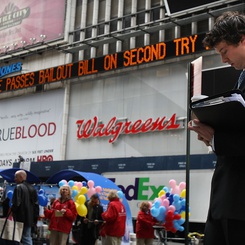According to a US congressional report, between 2009 and 2012, Apple funneled some 30bn dollars into an Irish subsidiary, without declaring any tax residence. This allowed the firm to bring in $74bn in profits, paying little or no income tax to any national government. Apple hadn’t just found a way to pay fewer taxes, they’d found the ultimate loophole: a way to pay virtually none at all.
Unfortunately, Apple’s case is by no means unique. Today’s multinationals are finding tax loopholes and bringing less and less cash into the public sector of developed economies. So what’s the problem? How can governments curtail this kind of tax evasion?
“There are two key arguments on how to deal with this tax avoidance issue,” says Anne Jeny-Cazavan. “While some argue in favor of more regulation and more detailed reporting, others believe that the sheer volume of reports drowns out important information. In general, past empirical disclosure literature[1] has suggested that more disclosure is good for users. But there is also evidence that it is possible to have too much disclosure, which may confuse users.”
Disclosure: if some is good then more must be better?
Already, the European Commission has begun discussing policy measures that would force companies to disclose revenues and profits on a country-by-country basis to crack down on tax avoidance. Last month, the European Union backed new disclosure rules for oil, gas and mining companies. And in a surprising turn, internal markets commissioner Michel Barnier also said that these disclosure rules would be extended to other corporations, an announcement made hot on the heels of an EU summit in Brussels this May where tax avoidance was the centre of discussion. But why is more disclosure considered a good thing?
First and foremost, professor Jeny-Cazavan says it’s important to remember that corporate disclosure is multi-dimensional[2]. When we talk about disclosure, we’re talking about regulated financial reports and financial statements, but also footnotes, management discussion and analysis. Some firms engage in voluntary communication, such as management forecasts, analysts’ presentations and conference calls, press releases, Internet sites, and other reports – herein lies the confusion.
"The motivation to engage in voluntary disclosure – perhaps excessively – is certainly out there. Empirical studies have shown that there are potentially three types of positive capital market impacts for firms that make extensive voluntary disclosures. Firms that engage in voluntary disclosure could (1) increase liquidity of the firm’s stock; (2) lower the cost of capital; and (3) reduce analysts’ forecasts volatility."
In addition, Professor Jeny-Cazavan’s more recent work has shown that, in the IPO context, the analyst forecast error decreases as the level of detail in the management forecast disclosures increases: a finding which suggests that the level of detail in forecast disclosures enhances the reliability of earnings forecasts.[3]
However, she goes on to explain the limitations of these kinds of findings. First, there are issues of endogeneity: firms with the highest disclosure ratings tend to also show the highest earnings performance. Results may be driven by firm performance rather than disclosure per se.
Second, many studies assume that, even in an efficient capital market, managers still have superior information compared to outside investors on their firms’ expected future performance. However, she underlines that accounting and auditing is often imperfect because managers face a tradeoff between making accounting decisions and disclosures to convey their private knowledge of firm’s performance to investors, and managing reported performance for contracting, political or corporate governance reasons.
But can you have too much of a good thing?
Voluntary disclosure isn’t always linked to positive outcomes. Most importantly, an excess of information can confuse investors, causing some information to fall by the wayside. This is an intense subject of debate: only last month, professor Jeny-Cazavan participated in an ICAEW Symposium – Financial Reporting Disclosures: Are They Out of Control? – that she says brought up some interesting points.
“For sure, too much information can negatively impact a firm’s cost of capital,” she explains, “particularly if investors perceive that other investors are ignoring relevant disclosures. That said, higher cost of capital are linked to investors’ perception that others are responding to irrelevant disclosures.”
“And in fully understanding this link, there is an important distinction to be made between private and public information. When agents have access to valuable private information, the welfare effect of increased public disclosures is ambiguous. The main idea here is that when different information is interpreted differently by different types of investors, the cost of capital increases. It leads to new arguments in favor of private information, versus public information as the main determinant of information asymmetry among investors.”
“But above all, information disclosed isn’t always useful to investors,” she adds. “In particular, the usefulness of information disclosed in the notes, but not recognized in the balance sheet and income statement, is extremely variable. While experimental research suggests that recognition versus disclosure influences financial statements users’ perception, empirical papers are inconclusive on whether disclosed information is processed completely, and whether recognition versus disclosure are equivalent in terms of their capital market implications.[4]”
In a recent paper, professor Jeny-Cazavan has examined whether managers’ decisions to capitalize or expense R&D expenditures, in the French context, convey information about the future performance of the firm[5]. It shows that the decision to capitalize R&D is generally associated with a negative or neutral impact on future performance, even after controlling for self-selection.
“While we cannot unambiguously establish whether our findings imply that management uses R&D capitalization to manage earnings or because it is unable to estimate the earning power of R&D projects,” she explains, “our results suggest that management is unable to truthfully convey information about future performance through its decision to capitalize R&D.”
“This is still a subject of intense debate,” concludes professor Jeny-Cazavan. “While the European Commission intends to force companies to disclose revenues and profits on a country-by-country basis to crack down on tax avoidance, new voices from regulators are calling for less financial reporting disclosures. And while financial reporting of intangible assets is still subject to a debate between advocates of a reform that would increase the mandatory disclosures, and to some extent recognition, of intangibles, at this date, empirical evidence is still inconclusive on this point and opens avenues for new research questions.”
“Looking ahead, researchers will be faced with questions pertaining to the accountability of extensive disclosures: Is it possible to maintain audit quality when disclosures are so extensive? It casts doubt on the reliability of the disclosures relied on by users and underline the role of auditors in enhancing the credibility of financial statements.”
[1] Healy and Palepu (2001) “Information asymmetry, corporate disclosure, and the capital markets: A review of the empirical disclosure literature”, Journal of Accounting and Economics, 31: 405-440.
[2] Excerpt from A. Jeny-Cazavan’s intervention during the ICAEW Symposium “Financial Reporting Disclosures: Are they out of control”, 36th Annual Congress of the EAA, Paris May 2013.
[3] A. Cazavan-Jeny and T. Jeanjean (2007) "Levels of voluntary disclosure in IPO prospectuses: An empirical analysis", Review of Accounting and Finance, 6(2): 131‑149.
[4] Bloomfield and Fischer (2011) “Disagreement and the Cost of Capital”, Journal of Accounting Research, 49(1): 41-68
[5] Cazavan-Jeny A., Jeanjean T., Joos P. (2011), “R&D reporting and future performance”, Journal of Accounting and Public Policy, 30: 145-165









